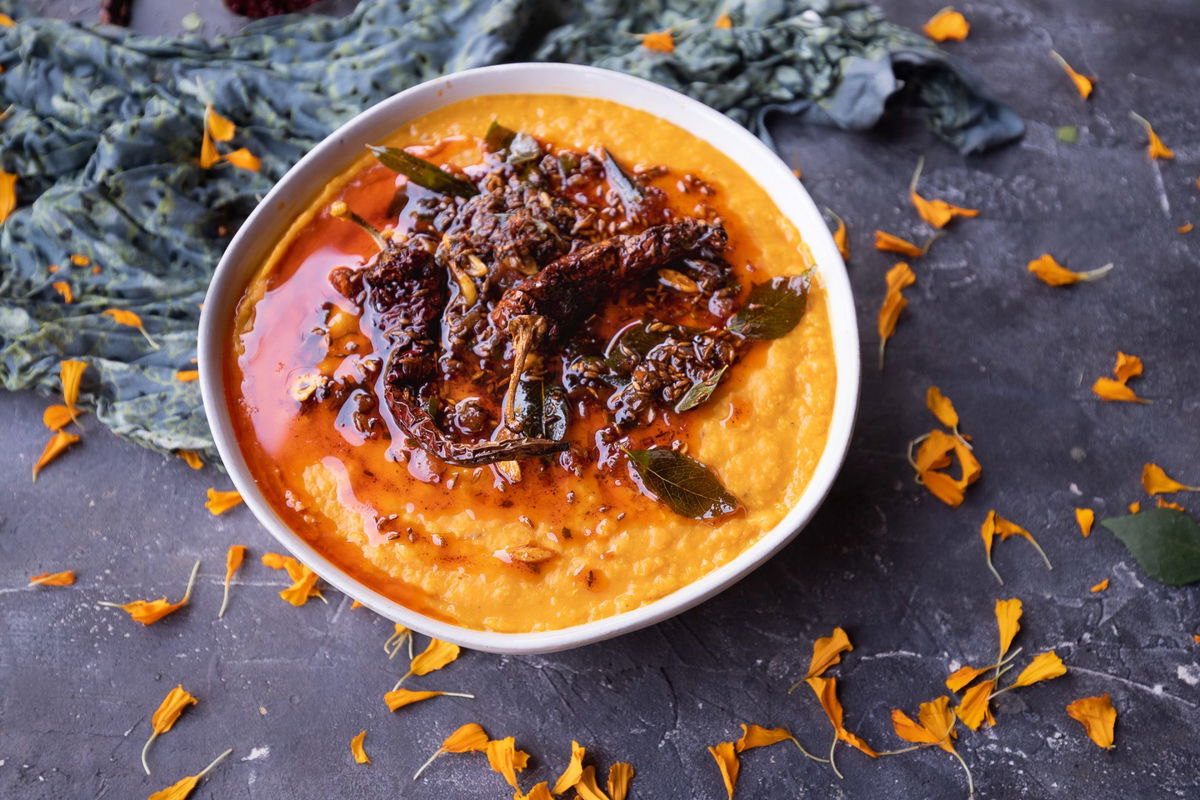If the only ghee you have had is ghee from a jar or ghee made from butter, you are missing out. Traditional ghee is very different. The cream is fermented into yogurt before it is churned into butter, giving it a more complex, mildly sour, and funky flavor. This is the type of ghee I used to watch my grandma make when I was a child.
About this Recipe

Ghee is often made from sweet cream butter, which is not fermented. But traditional ghee is made by making cream into yogurt, then the yogurt is churned into butter before being clarified into ghee.
The butter is very much like European cultured butter, and these flavors carry forward into the ghee as well, offering some new complex flavors in any dish where it is used.
Because it is more traditional and healthier, this is considered the “Ayurvedic” way of making ghee. When you ferment milk, some of the sugars are converted into butyric acid. According to netmeds.com, “Butyric acid is well-known to support digestive health, reduce inflammation and lowers the risk of diseases and promote overall health,” supporting the ayurvedic notion that it is healthier.
Butyric acid is the compound that gives a funky flavor to the desi ghee. It has a more ripe flavor than the regular ghee that you make out of just butter.
Ingredients
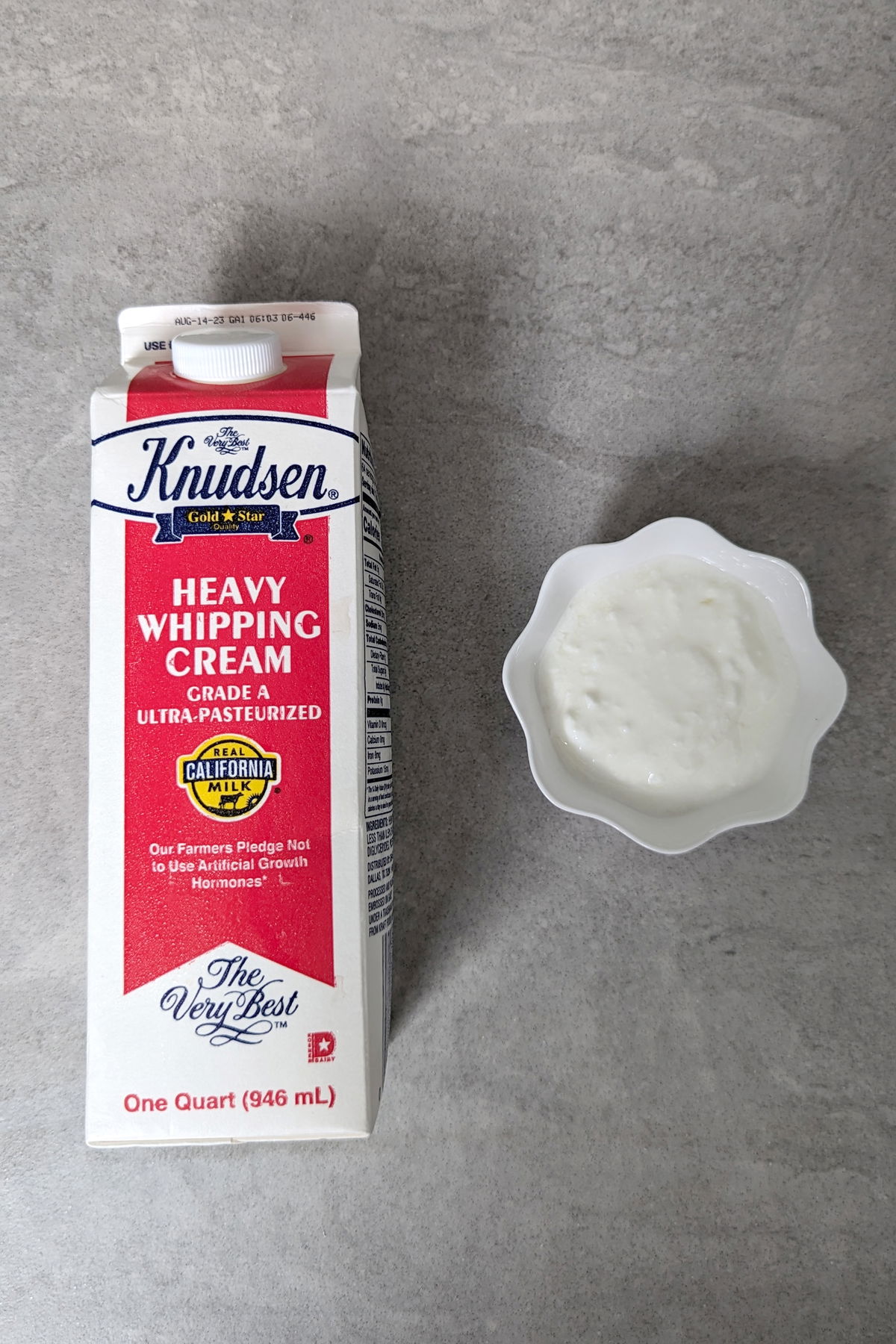
The ingredients are simple:
- Cream – often labeled “heavy whipping cream,” butter is made from cream.
- Yogurt – yogurt is used as a starter since it contains the live cultures we need to turn the cream into yogurt. Use plain, unflavored, unsweetened yogurt.
Making the Yogurt
I’ve already posted two methods for making yogurt, one with the Instant Pot and one on the stovetop. Here, the process is the same, but instead of using milk, we use cream.
I used to watch my grandma make traditional ghee as a child. Her process involved collecting the clotted cream or Malai from her daily batch of yogurt and saving it in the fridge for a few days. Then she would make the butter and subsequently the ghee.
But I don’t make yogurt every day. And I don’t have easy access to milk straight from the cow (or buffalo) like my grandma did. Her milk did not go through the homogenization and pasteurization our milk goes through in the US.
So I had to test a few different theories before coming up with a good, reliable recipe for making makhan that produced consistent results.
I first tried making it with my “desi yogurt,” which is a little fattier than yogurt from whole milk, but that was too low in fat.
I eventually found that starting with heavy cream is the key.
Making the Makhan (Cultured Butter)
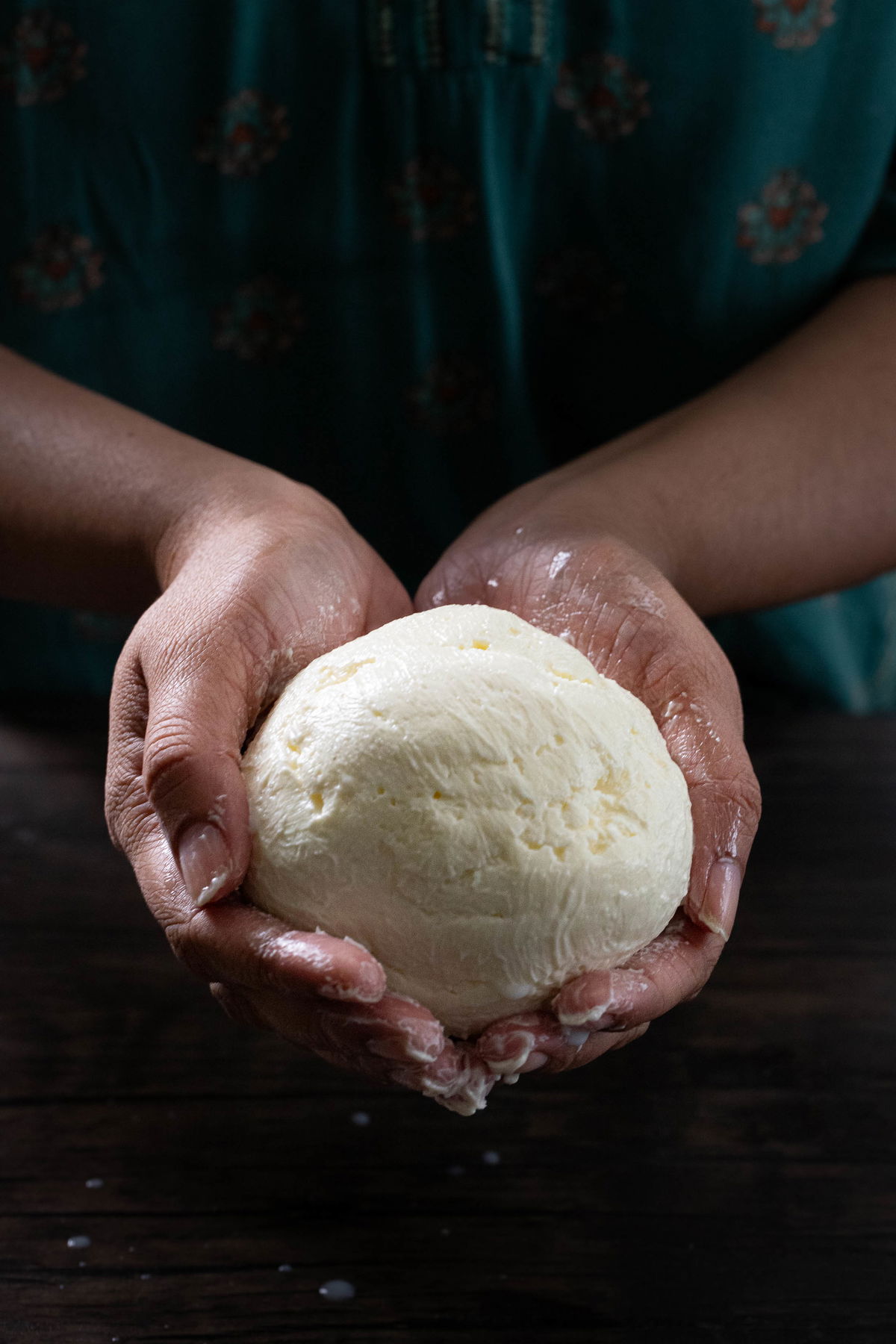
Making the makhan was the tricky part of the recipe because it’s not something I do very often. This method of making butter from yogurt is different from making butter from cream because you are starting with something that is already pretty solid. This rich, creamy yogurt has a consistency that is almost as thick as sour cream.
It took me several attempts to get the butter to form, but in the end, I found a technique that worked consistently for me, so follow these instructions closely to save yourself some effort. The main thing I thought I would do was pour icy water into the yogurt before blending. My grandmother used to do that, but she didn’t use a blender, she did this by hand with an Indian butter churner.
After a lot of trial and error, I found it was best to put cold yogurt into a Vitamix (or any high-powered blender), with no water. Then run the blender on high, and stop it when the butter separates from the whey – it took just under one minute for me each time. Blending with the Vitamix creates a lot of heat, which will melt your butter if you run the blender for too long.
When I make this, I use a quart of cream. The recipe for the yogurt scales very easily, but it is important when you make the butter that you break it up into batches. You don’t want to overload your blender because that will create too much heat before the butter forms. I separate what amounts to about a quart of yogurt into three parts before I blend it.
After that, you have to wash your butter. That is when you finally use the icy water. The ice-cold water helps the butter stiffen so you can form it into a ball and wash off any remaining whey.
- Fresh butter is best served with parathas or rotis. It is often made in many parts of India for Janmashtami (Krishna’s birthday) because it is a favorite of Krishna. My family always made a big batch of Makhan for Janmashtami.
Storing the Butter
If you stop at this point, you will have a very tasty makhan(makkhan), or cultured butter.
Makhan stores well in the refrigerator for about 2-3 weeks. Store it in water and swap out the water every few days to keep it fresh.
This is traditional butter that dates back thousands of years before there was refrigeration, and in a sense, this is a preservation technique for milk. Leaving it out at room temperature will not cause it to spoil, but it will become more sour and develop off flavors over time.
Making the Ghee
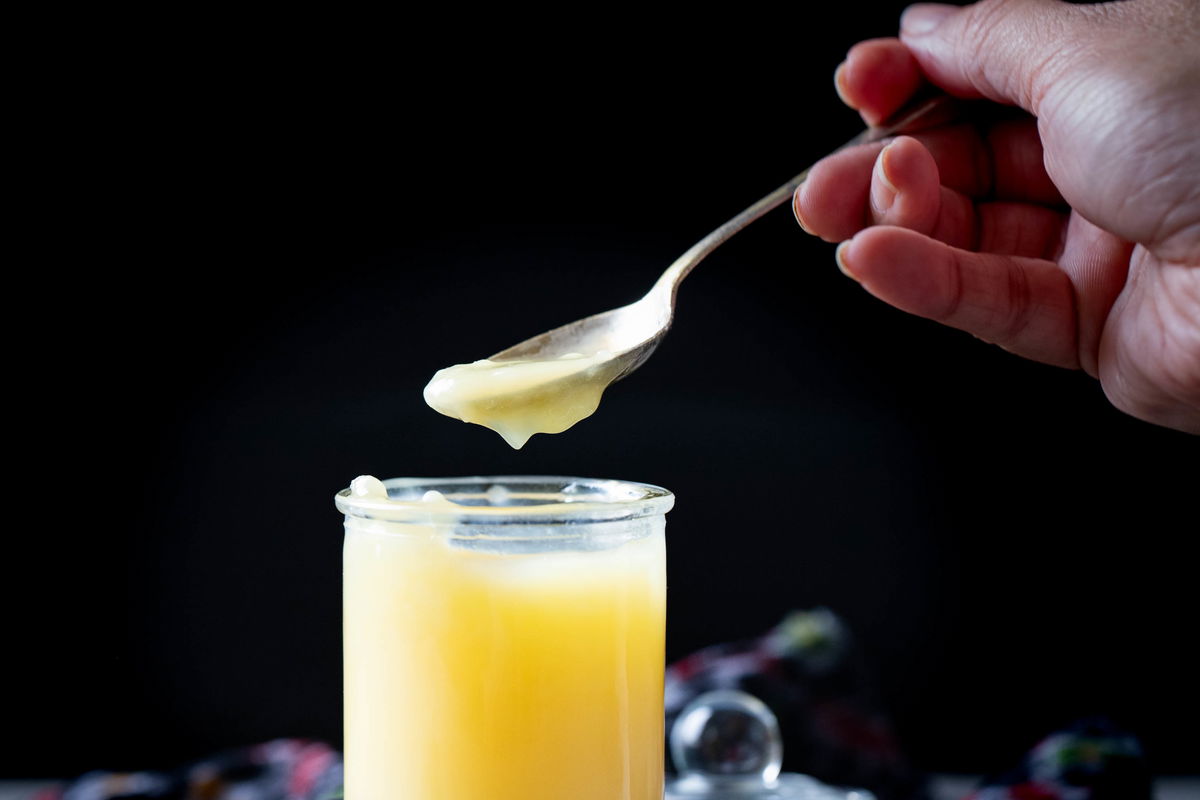
Make the ghee the same way as making ghee from store-bought butter. Make sure to use a heavy-bottomed pan and low heat not to burn the butter as it clarifies. One thing you might notice that is different from this video versus my older video on making ghee is that I am removing the foam as the butter cooks. It isn’t necessary to do this, but I like to in order to have a better view of the milk solids as they drop to the bottom.
When you make ghee, you want to cook these milk solids just enough that they add that caramel color and richness that is characteristic of ghee without burning it. There is a bit of an art to it, but truth be told, I prefer the taste of the ghee when it gets just a little bit darker and more flavorful than typical ghee, as long as it doesn’t taste burnt.
Storing the Ghee
Ghee can be stored in an airtight jar at room temperature. It is best kept in a cool, dark pantry, just like any other oil. Because it is not a vegetable oil, ghee is less prone to becoming rancid.
Traditional Desi Ghee and Makhan
Traditional ghee is different from ghee from butter. It is fermented into yogurt before it is churned into butter, giving it a more complex, mildly sour, and funky flavor.
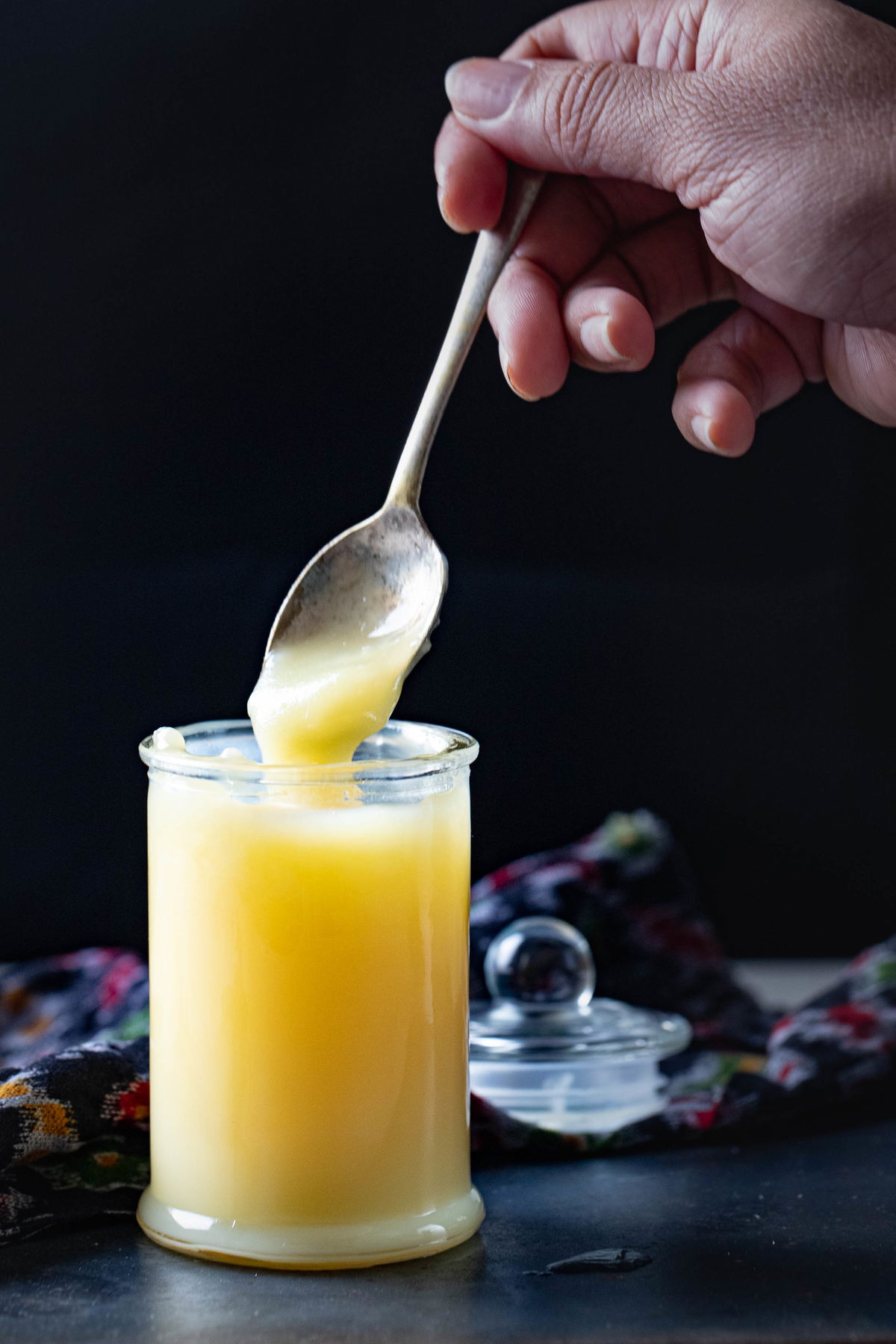
Ingredients
- 1 quart heavy whipping cream
- 1/4 cup plain yogurt
Instructions
Make the Yogurt
- Start by heating the whipping cream to boiling temperature. You can do this on the stovetop or in an Instant Pot using the yogurt preset. If using the stovetop, be sure to use a heavy-bottomed pot and take care not to burn the cream.
- When the milk comes to a boil, immediately turn off the heat and let it cool (with a loose-fitting lid on) for about 1 hour. It should be cool enough to touch, between 100°-120° is ideal.
- Mix in the yogurt. Stir until thoroughly mixed. Cover the mixture.
- If using an Instant Pot, press “Yogurt” until it says 24 hours, otherwise, store it in a warm spot in the kitchen, such as an oven turned off or on top of the refrigerator.
- After 24 hours, your yogurt should be set. The Instant Pot tends to be very reliable since the temperature is fully controlled, but it may take more or less time if you are not using an Instant Pot. When the yogurt is set, transfer it into a smaller container and put it in the refrigerator for at least 4 hours to chill.
Make the Butter
- Take about 1/3 of the yogurt and add it to a high-powered blender, such as a Vitamix.
- Blend the yogurt until it separates from the whey. This should take about 50-55 seconds, be sure not to over blend or the heat may start to melt the butter before it forms. If it does melt, refrigerate until cold and try again.
- Transfer the butter to a bowl and pour ice-cold water over it. Use your hands to compact the butter into a ball. Dump the water and rinse again with ice-cold water.
- Repeat with the next 1/3 portion of yogurt, then again with the final portion.
Make the Ghee
- Add the butter to a heavy-bottomed pot. Heat to melt the butter. You can do this part on medium or medium-high heat if you stir often to prevent burning.
- Once the butter has fully melted, reduce the heat to very low. Simmer to evaporate the water and allow the milk solids to drop to the bottom. Do not stir, but you can scrape the foam off the top with a slotted spoon as it forms.
- It is done when the foam has dissipated and the solids have dropped to the bottom and turned a golden color. You will also notice a change in the sound coming from the simmering oil as water is no longer escaping as steam. Remove from heat and allow it to cool until you are comfortable pouring this liquid into another container.
- Pour the liquid ghee into a jar. Use a fine mesh strainer to ensure no particles remain in the ghee.
